Business and Society: An Analysis of the Rana Plaza Factory Collapse
VerifiedAdded on 2022/12/15
|25
|4700
|232
Report
AI Summary
This report provides a comprehensive analysis of the Rana Plaza factory collapse in Bangladesh, focusing on business ethics, stakeholder analysis, and corporate social responsibility. The study examines the key issues, including structural problems, unethical practices, and the pressures of the fast fashion industry. It identifies and describes the relevant stakeholders, such as international buyers, suppliers, the Bangladesh government, and workers, evaluating their power and responsibilities. The analysis reveals the ethical failures of the factory owners and international buyers, highlighting their roles in promoting unsafe working conditions and inadequate compensation. The report concludes with recommendations for preventing future disasters, emphasizing the need for improved training, labor policies, and supply chain monitoring. The analysis utilizes stakeholder power and ethical frameworks (utilitarian, rights, and justice approaches) to evaluate the actions of key players and suggest strategies to address worker abuse and improve global corporate citizenship. The report offers insights into the complex interplay of business and society, offering suggestions for a more ethical and sustainable approach to the garment industry.
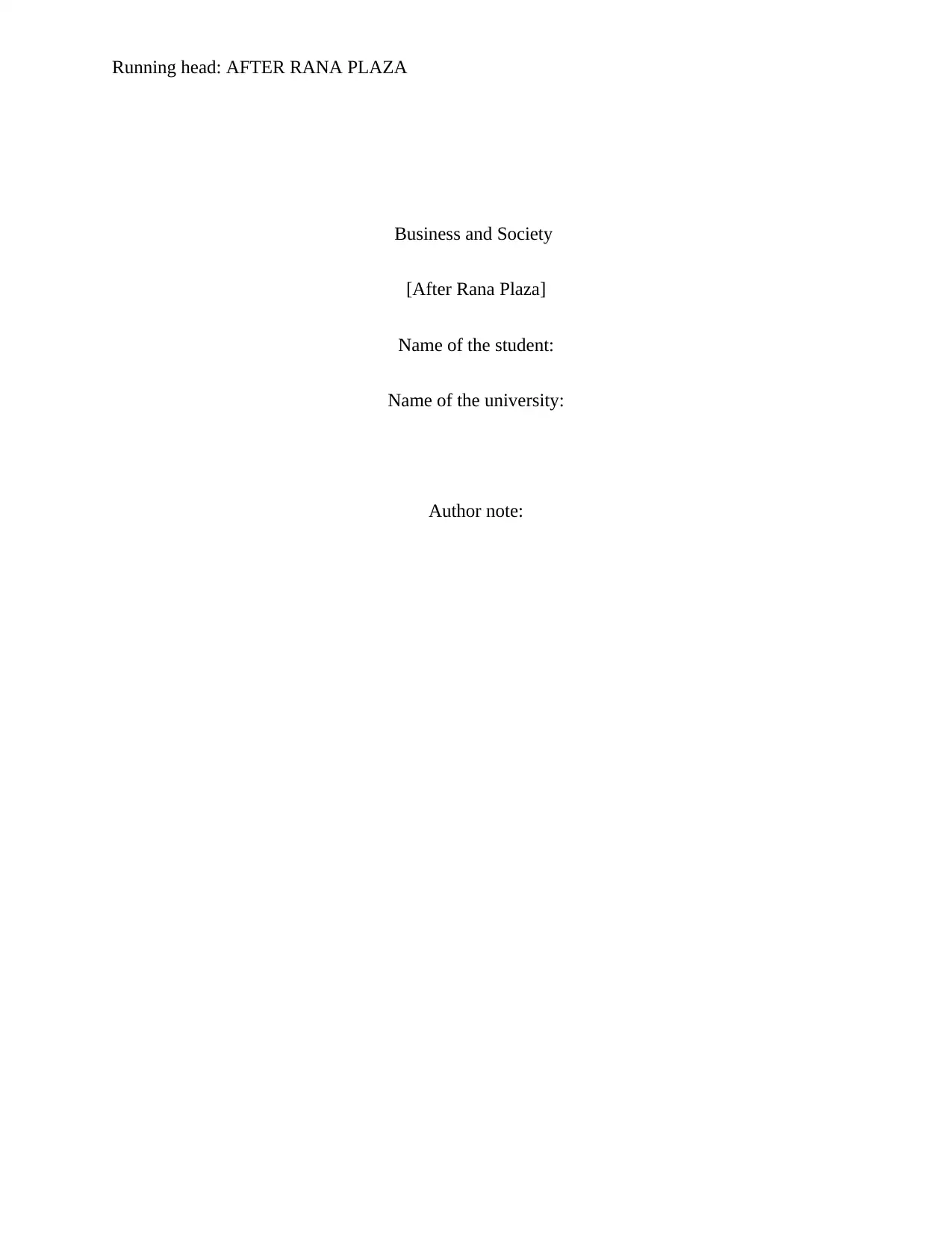
Running head: AFTER RANA PLAZA
Business and Society
[After Rana Plaza]
Name of the student:
Name of the university:
Author note:
Business and Society
[After Rana Plaza]
Name of the student:
Name of the university:
Author note:
Paraphrase This Document
Need a fresh take? Get an instant paraphrase of this document with our AI Paraphraser
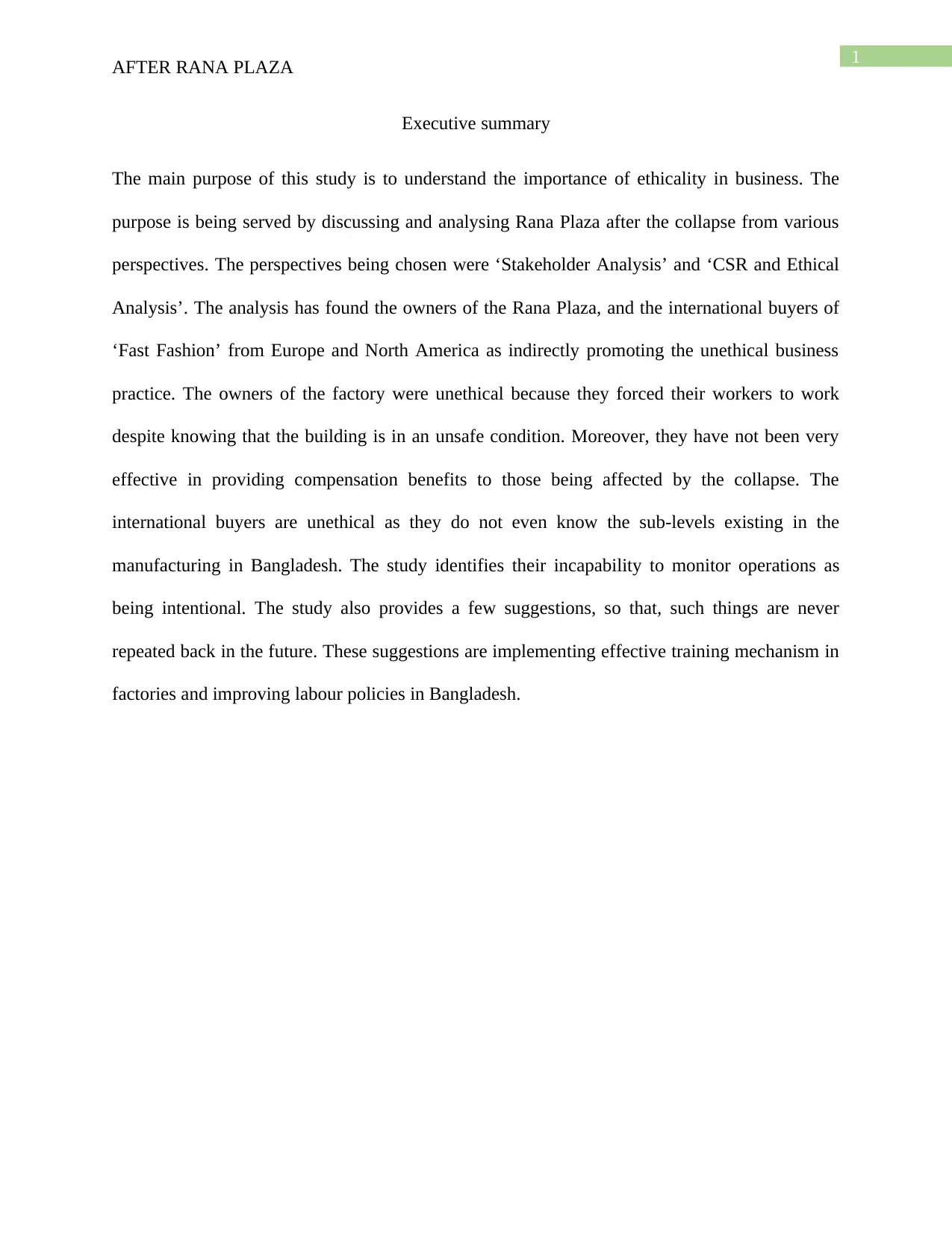
1
AFTER RANA PLAZA
Executive summary
The main purpose of this study is to understand the importance of ethicality in business. The
purpose is being served by discussing and analysing Rana Plaza after the collapse from various
perspectives. The perspectives being chosen were ‘Stakeholder Analysis’ and ‘CSR and Ethical
Analysis’. The analysis has found the owners of the Rana Plaza, and the international buyers of
‘Fast Fashion’ from Europe and North America as indirectly promoting the unethical business
practice. The owners of the factory were unethical because they forced their workers to work
despite knowing that the building is in an unsafe condition. Moreover, they have not been very
effective in providing compensation benefits to those being affected by the collapse. The
international buyers are unethical as they do not even know the sub-levels existing in the
manufacturing in Bangladesh. The study identifies their incapability to monitor operations as
being intentional. The study also provides a few suggestions, so that, such things are never
repeated back in the future. These suggestions are implementing effective training mechanism in
factories and improving labour policies in Bangladesh.
AFTER RANA PLAZA
Executive summary
The main purpose of this study is to understand the importance of ethicality in business. The
purpose is being served by discussing and analysing Rana Plaza after the collapse from various
perspectives. The perspectives being chosen were ‘Stakeholder Analysis’ and ‘CSR and Ethical
Analysis’. The analysis has found the owners of the Rana Plaza, and the international buyers of
‘Fast Fashion’ from Europe and North America as indirectly promoting the unethical business
practice. The owners of the factory were unethical because they forced their workers to work
despite knowing that the building is in an unsafe condition. Moreover, they have not been very
effective in providing compensation benefits to those being affected by the collapse. The
international buyers are unethical as they do not even know the sub-levels existing in the
manufacturing in Bangladesh. The study identifies their incapability to monitor operations as
being intentional. The study also provides a few suggestions, so that, such things are never
repeated back in the future. These suggestions are implementing effective training mechanism in
factories and improving labour policies in Bangladesh.
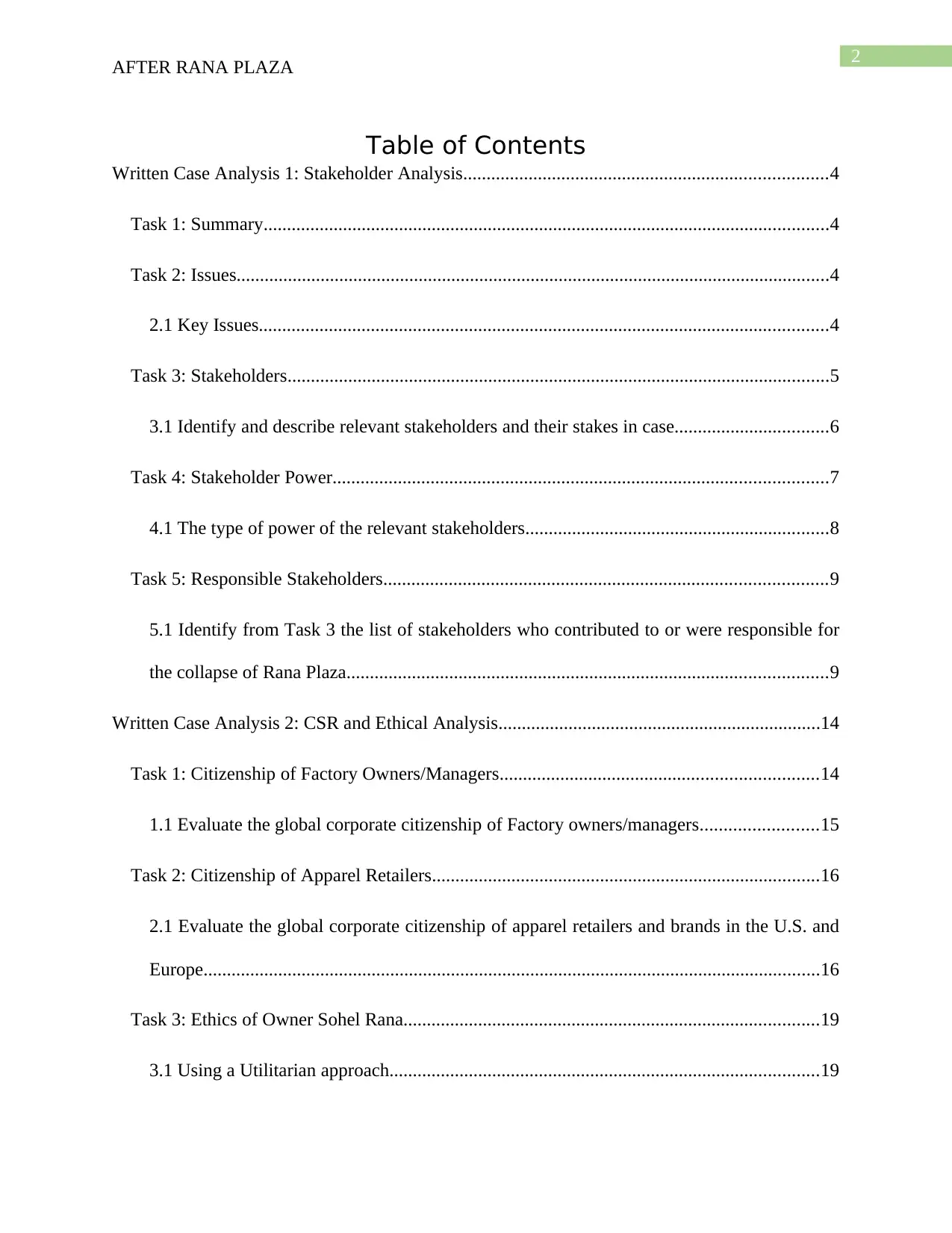
2
AFTER RANA PLAZA
Table of Contents
Written Case Analysis 1: Stakeholder Analysis..............................................................................4
Task 1: Summary.........................................................................................................................4
Task 2: Issues...............................................................................................................................4
2.1 Key Issues..........................................................................................................................4
Task 3: Stakeholders....................................................................................................................5
3.1 Identify and describe relevant stakeholders and their stakes in case.................................6
Task 4: Stakeholder Power..........................................................................................................7
4.1 The type of power of the relevant stakeholders.................................................................8
Task 5: Responsible Stakeholders...............................................................................................9
5.1 Identify from Task 3 the list of stakeholders who contributed to or were responsible for
the collapse of Rana Plaza.......................................................................................................9
Written Case Analysis 2: CSR and Ethical Analysis.....................................................................14
Task 1: Citizenship of Factory Owners/Managers....................................................................14
1.1 Evaluate the global corporate citizenship of Factory owners/managers.........................15
Task 2: Citizenship of Apparel Retailers...................................................................................16
2.1 Evaluate the global corporate citizenship of apparel retailers and brands in the U.S. and
Europe....................................................................................................................................16
Task 3: Ethics of Owner Sohel Rana.........................................................................................19
3.1 Using a Utilitarian approach............................................................................................19
AFTER RANA PLAZA
Table of Contents
Written Case Analysis 1: Stakeholder Analysis..............................................................................4
Task 1: Summary.........................................................................................................................4
Task 2: Issues...............................................................................................................................4
2.1 Key Issues..........................................................................................................................4
Task 3: Stakeholders....................................................................................................................5
3.1 Identify and describe relevant stakeholders and their stakes in case.................................6
Task 4: Stakeholder Power..........................................................................................................7
4.1 The type of power of the relevant stakeholders.................................................................8
Task 5: Responsible Stakeholders...............................................................................................9
5.1 Identify from Task 3 the list of stakeholders who contributed to or were responsible for
the collapse of Rana Plaza.......................................................................................................9
Written Case Analysis 2: CSR and Ethical Analysis.....................................................................14
Task 1: Citizenship of Factory Owners/Managers....................................................................14
1.1 Evaluate the global corporate citizenship of Factory owners/managers.........................15
Task 2: Citizenship of Apparel Retailers...................................................................................16
2.1 Evaluate the global corporate citizenship of apparel retailers and brands in the U.S. and
Europe....................................................................................................................................16
Task 3: Ethics of Owner Sohel Rana.........................................................................................19
3.1 Using a Utilitarian approach............................................................................................19
⊘ This is a preview!⊘
Do you want full access?
Subscribe today to unlock all pages.

Trusted by 1+ million students worldwide
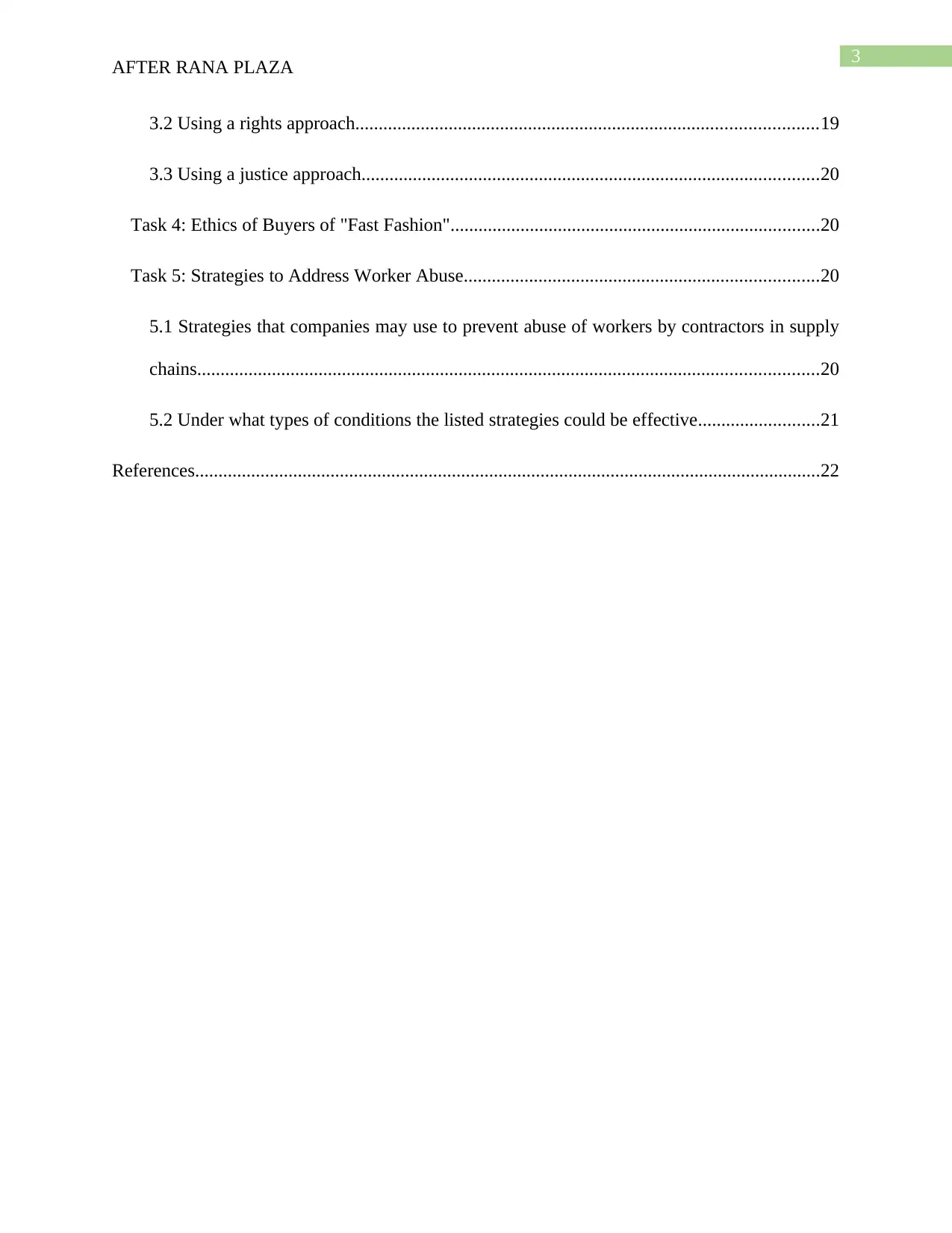
3
AFTER RANA PLAZA
3.2 Using a rights approach...................................................................................................19
3.3 Using a justice approach..................................................................................................20
Task 4: Ethics of Buyers of "Fast Fashion"...............................................................................20
Task 5: Strategies to Address Worker Abuse............................................................................20
5.1 Strategies that companies may use to prevent abuse of workers by contractors in supply
chains.....................................................................................................................................20
5.2 Under what types of conditions the listed strategies could be effective..........................21
References......................................................................................................................................22
AFTER RANA PLAZA
3.2 Using a rights approach...................................................................................................19
3.3 Using a justice approach..................................................................................................20
Task 4: Ethics of Buyers of "Fast Fashion"...............................................................................20
Task 5: Strategies to Address Worker Abuse............................................................................20
5.1 Strategies that companies may use to prevent abuse of workers by contractors in supply
chains.....................................................................................................................................20
5.2 Under what types of conditions the listed strategies could be effective..........................21
References......................................................................................................................................22
Paraphrase This Document
Need a fresh take? Get an instant paraphrase of this document with our AI Paraphraser
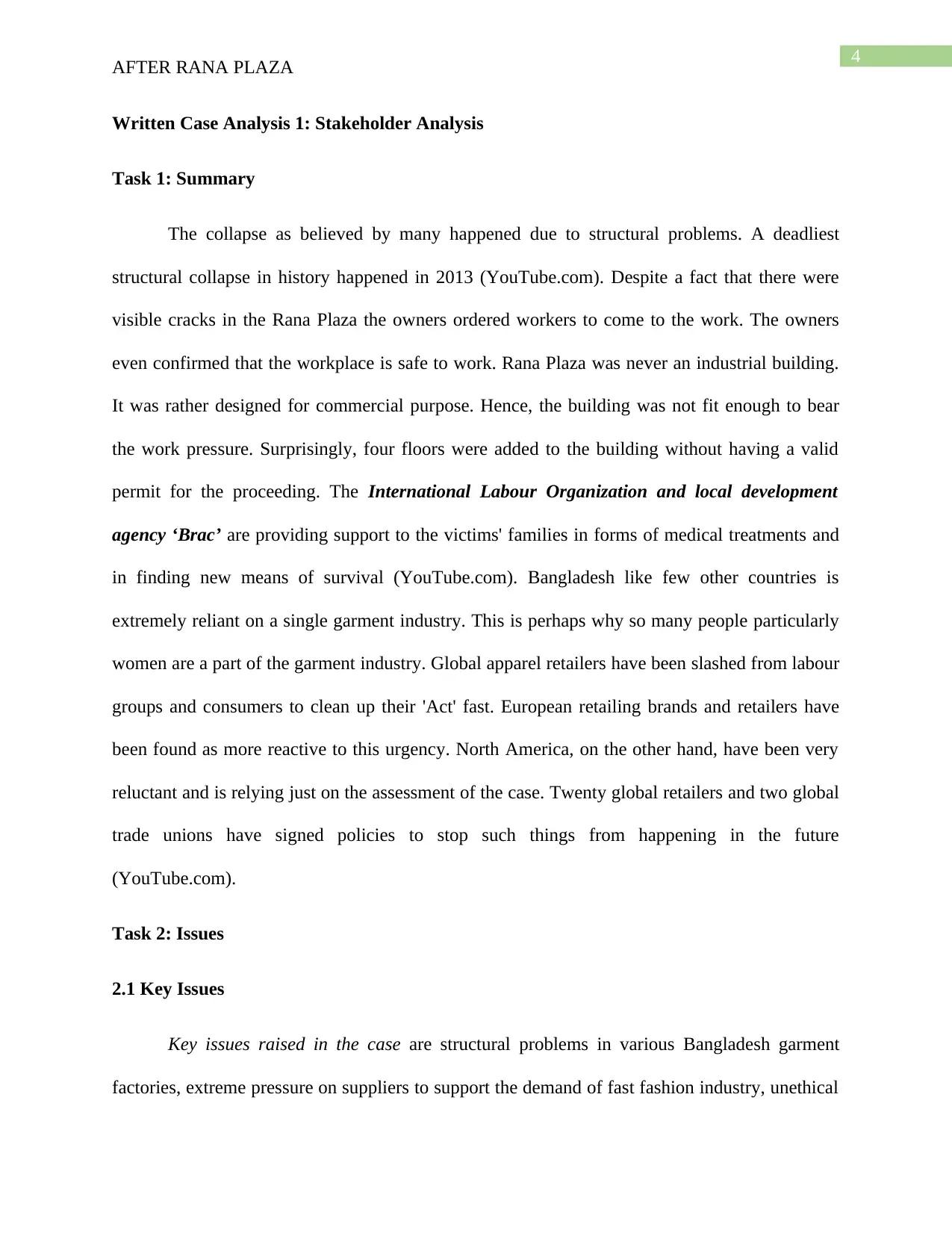
4
AFTER RANA PLAZA
Written Case Analysis 1: Stakeholder Analysis
Task 1: Summary
The collapse as believed by many happened due to structural problems. A deadliest
structural collapse in history happened in 2013 (YouTube.com). Despite a fact that there were
visible cracks in the Rana Plaza the owners ordered workers to come to the work. The owners
even confirmed that the workplace is safe to work. Rana Plaza was never an industrial building.
It was rather designed for commercial purpose. Hence, the building was not fit enough to bear
the work pressure. Surprisingly, four floors were added to the building without having a valid
permit for the proceeding. The International Labour Organization and local development
agency ‘Brac’ are providing support to the victims' families in forms of medical treatments and
in finding new means of survival (YouTube.com). Bangladesh like few other countries is
extremely reliant on a single garment industry. This is perhaps why so many people particularly
women are a part of the garment industry. Global apparel retailers have been slashed from labour
groups and consumers to clean up their 'Act' fast. European retailing brands and retailers have
been found as more reactive to this urgency. North America, on the other hand, have been very
reluctant and is relying just on the assessment of the case. Twenty global retailers and two global
trade unions have signed policies to stop such things from happening in the future
(YouTube.com).
Task 2: Issues
2.1 Key Issues
Key issues raised in the case are structural problems in various Bangladesh garment
factories, extreme pressure on suppliers to support the demand of fast fashion industry, unethical
AFTER RANA PLAZA
Written Case Analysis 1: Stakeholder Analysis
Task 1: Summary
The collapse as believed by many happened due to structural problems. A deadliest
structural collapse in history happened in 2013 (YouTube.com). Despite a fact that there were
visible cracks in the Rana Plaza the owners ordered workers to come to the work. The owners
even confirmed that the workplace is safe to work. Rana Plaza was never an industrial building.
It was rather designed for commercial purpose. Hence, the building was not fit enough to bear
the work pressure. Surprisingly, four floors were added to the building without having a valid
permit for the proceeding. The International Labour Organization and local development
agency ‘Brac’ are providing support to the victims' families in forms of medical treatments and
in finding new means of survival (YouTube.com). Bangladesh like few other countries is
extremely reliant on a single garment industry. This is perhaps why so many people particularly
women are a part of the garment industry. Global apparel retailers have been slashed from labour
groups and consumers to clean up their 'Act' fast. European retailing brands and retailers have
been found as more reactive to this urgency. North America, on the other hand, have been very
reluctant and is relying just on the assessment of the case. Twenty global retailers and two global
trade unions have signed policies to stop such things from happening in the future
(YouTube.com).
Task 2: Issues
2.1 Key Issues
Key issues raised in the case are structural problems in various Bangladesh garment
factories, extreme pressure on suppliers to support the demand of fast fashion industry, unethical
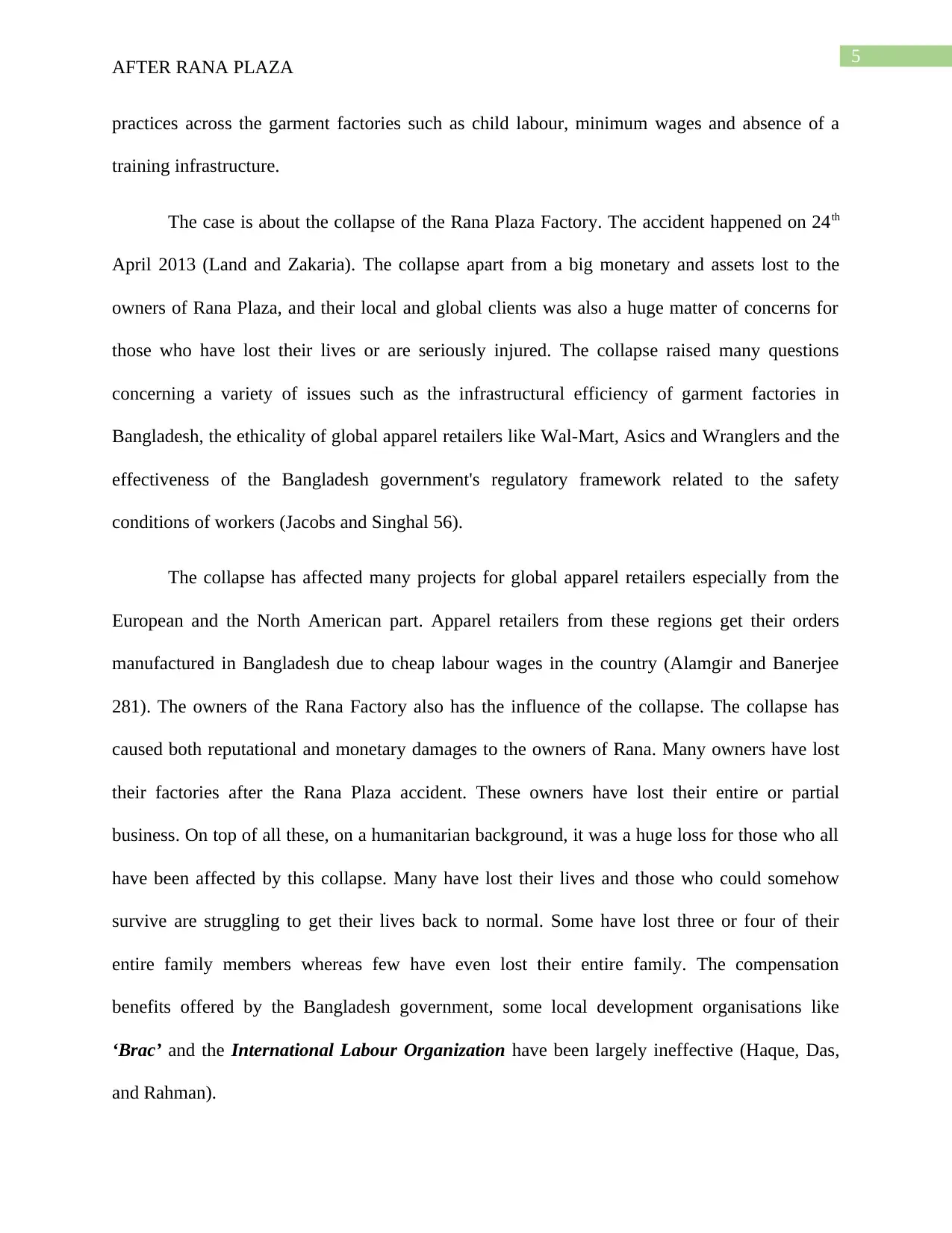
5
AFTER RANA PLAZA
practices across the garment factories such as child labour, minimum wages and absence of a
training infrastructure.
The case is about the collapse of the Rana Plaza Factory. The accident happened on 24th
April 2013 (Land and Zakaria). The collapse apart from a big monetary and assets lost to the
owners of Rana Plaza, and their local and global clients was also a huge matter of concerns for
those who have lost their lives or are seriously injured. The collapse raised many questions
concerning a variety of issues such as the infrastructural efficiency of garment factories in
Bangladesh, the ethicality of global apparel retailers like Wal-Mart, Asics and Wranglers and the
effectiveness of the Bangladesh government's regulatory framework related to the safety
conditions of workers (Jacobs and Singhal 56).
The collapse has affected many projects for global apparel retailers especially from the
European and the North American part. Apparel retailers from these regions get their orders
manufactured in Bangladesh due to cheap labour wages in the country (Alamgir and Banerjee
281). The owners of the Rana Factory also has the influence of the collapse. The collapse has
caused both reputational and monetary damages to the owners of Rana. Many owners have lost
their factories after the Rana Plaza accident. These owners have lost their entire or partial
business. On top of all these, on a humanitarian background, it was a huge loss for those who all
have been affected by this collapse. Many have lost their lives and those who could somehow
survive are struggling to get their lives back to normal. Some have lost three or four of their
entire family members whereas few have even lost their entire family. The compensation
benefits offered by the Bangladesh government, some local development organisations like
‘Brac’ and the International Labour Organization have been largely ineffective (Haque, Das,
and Rahman).
AFTER RANA PLAZA
practices across the garment factories such as child labour, minimum wages and absence of a
training infrastructure.
The case is about the collapse of the Rana Plaza Factory. The accident happened on 24th
April 2013 (Land and Zakaria). The collapse apart from a big monetary and assets lost to the
owners of Rana Plaza, and their local and global clients was also a huge matter of concerns for
those who have lost their lives or are seriously injured. The collapse raised many questions
concerning a variety of issues such as the infrastructural efficiency of garment factories in
Bangladesh, the ethicality of global apparel retailers like Wal-Mart, Asics and Wranglers and the
effectiveness of the Bangladesh government's regulatory framework related to the safety
conditions of workers (Jacobs and Singhal 56).
The collapse has affected many projects for global apparel retailers especially from the
European and the North American part. Apparel retailers from these regions get their orders
manufactured in Bangladesh due to cheap labour wages in the country (Alamgir and Banerjee
281). The owners of the Rana Factory also has the influence of the collapse. The collapse has
caused both reputational and monetary damages to the owners of Rana. Many owners have lost
their factories after the Rana Plaza accident. These owners have lost their entire or partial
business. On top of all these, on a humanitarian background, it was a huge loss for those who all
have been affected by this collapse. Many have lost their lives and those who could somehow
survive are struggling to get their lives back to normal. Some have lost three or four of their
entire family members whereas few have even lost their entire family. The compensation
benefits offered by the Bangladesh government, some local development organisations like
‘Brac’ and the International Labour Organization have been largely ineffective (Haque, Das,
and Rahman).
⊘ This is a preview!⊘
Do you want full access?
Subscribe today to unlock all pages.

Trusted by 1+ million students worldwide
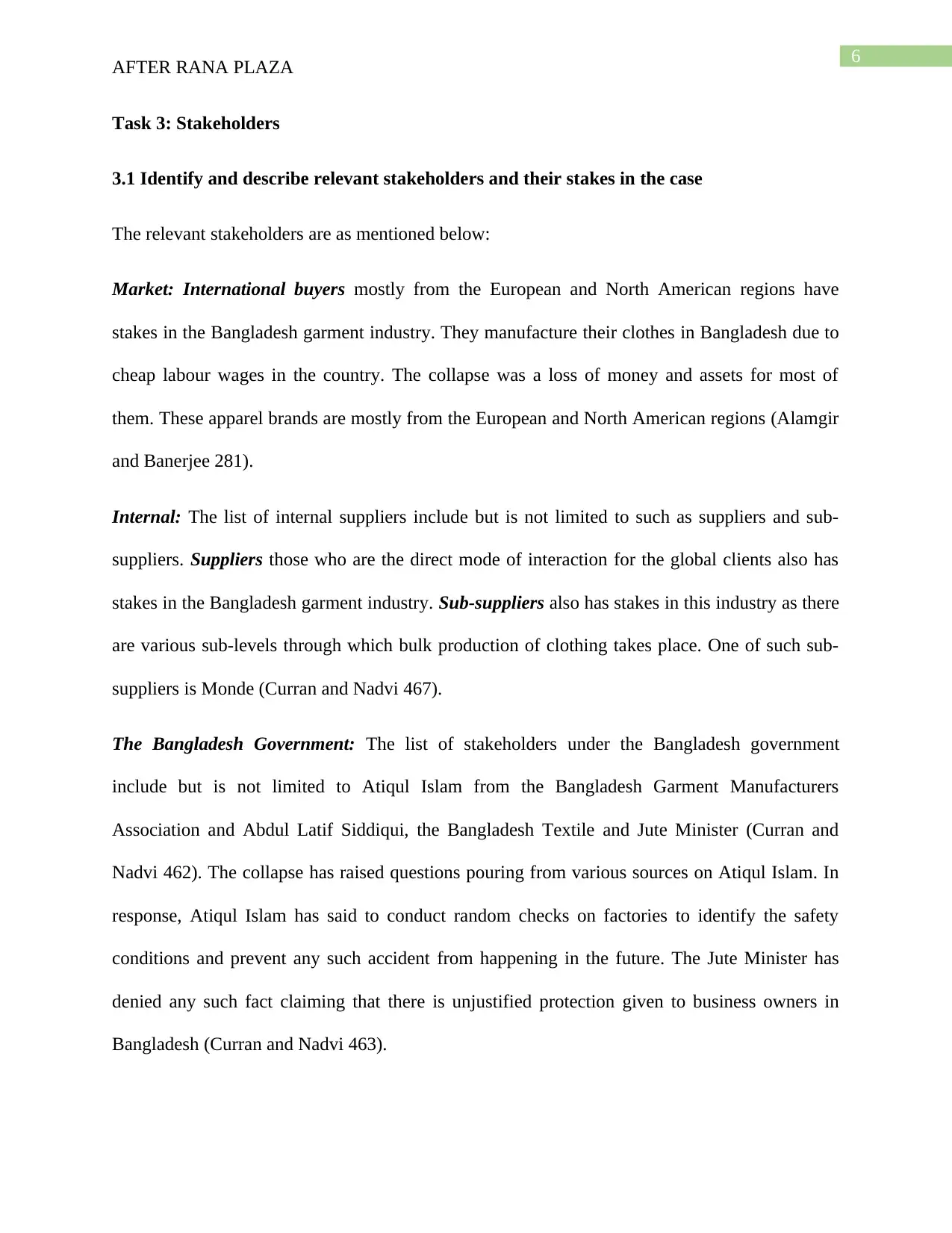
6
AFTER RANA PLAZA
Task 3: Stakeholders
3.1 Identify and describe relevant stakeholders and their stakes in the case
The relevant stakeholders are as mentioned below:
Market: International buyers mostly from the European and North American regions have
stakes in the Bangladesh garment industry. They manufacture their clothes in Bangladesh due to
cheap labour wages in the country. The collapse was a loss of money and assets for most of
them. These apparel brands are mostly from the European and North American regions (Alamgir
and Banerjee 281).
Internal: The list of internal suppliers include but is not limited to such as suppliers and sub-
suppliers. Suppliers those who are the direct mode of interaction for the global clients also has
stakes in the Bangladesh garment industry. Sub-suppliers also has stakes in this industry as there
are various sub-levels through which bulk production of clothing takes place. One of such sub-
suppliers is Monde (Curran and Nadvi 467).
The Bangladesh Government: The list of stakeholders under the Bangladesh government
include but is not limited to Atiqul Islam from the Bangladesh Garment Manufacturers
Association and Abdul Latif Siddiqui, the Bangladesh Textile and Jute Minister (Curran and
Nadvi 462). The collapse has raised questions pouring from various sources on Atiqul Islam. In
response, Atiqul Islam has said to conduct random checks on factories to identify the safety
conditions and prevent any such accident from happening in the future. The Jute Minister has
denied any such fact claiming that there is unjustified protection given to business owners in
Bangladesh (Curran and Nadvi 463).
AFTER RANA PLAZA
Task 3: Stakeholders
3.1 Identify and describe relevant stakeholders and their stakes in the case
The relevant stakeholders are as mentioned below:
Market: International buyers mostly from the European and North American regions have
stakes in the Bangladesh garment industry. They manufacture their clothes in Bangladesh due to
cheap labour wages in the country. The collapse was a loss of money and assets for most of
them. These apparel brands are mostly from the European and North American regions (Alamgir
and Banerjee 281).
Internal: The list of internal suppliers include but is not limited to such as suppliers and sub-
suppliers. Suppliers those who are the direct mode of interaction for the global clients also has
stakes in the Bangladesh garment industry. Sub-suppliers also has stakes in this industry as there
are various sub-levels through which bulk production of clothing takes place. One of such sub-
suppliers is Monde (Curran and Nadvi 467).
The Bangladesh Government: The list of stakeholders under the Bangladesh government
include but is not limited to Atiqul Islam from the Bangladesh Garment Manufacturers
Association and Abdul Latif Siddiqui, the Bangladesh Textile and Jute Minister (Curran and
Nadvi 462). The collapse has raised questions pouring from various sources on Atiqul Islam. In
response, Atiqul Islam has said to conduct random checks on factories to identify the safety
conditions and prevent any such accident from happening in the future. The Jute Minister has
denied any such fact claiming that there is unjustified protection given to business owners in
Bangladesh (Curran and Nadvi 463).
Paraphrase This Document
Need a fresh take? Get an instant paraphrase of this document with our AI Paraphraser
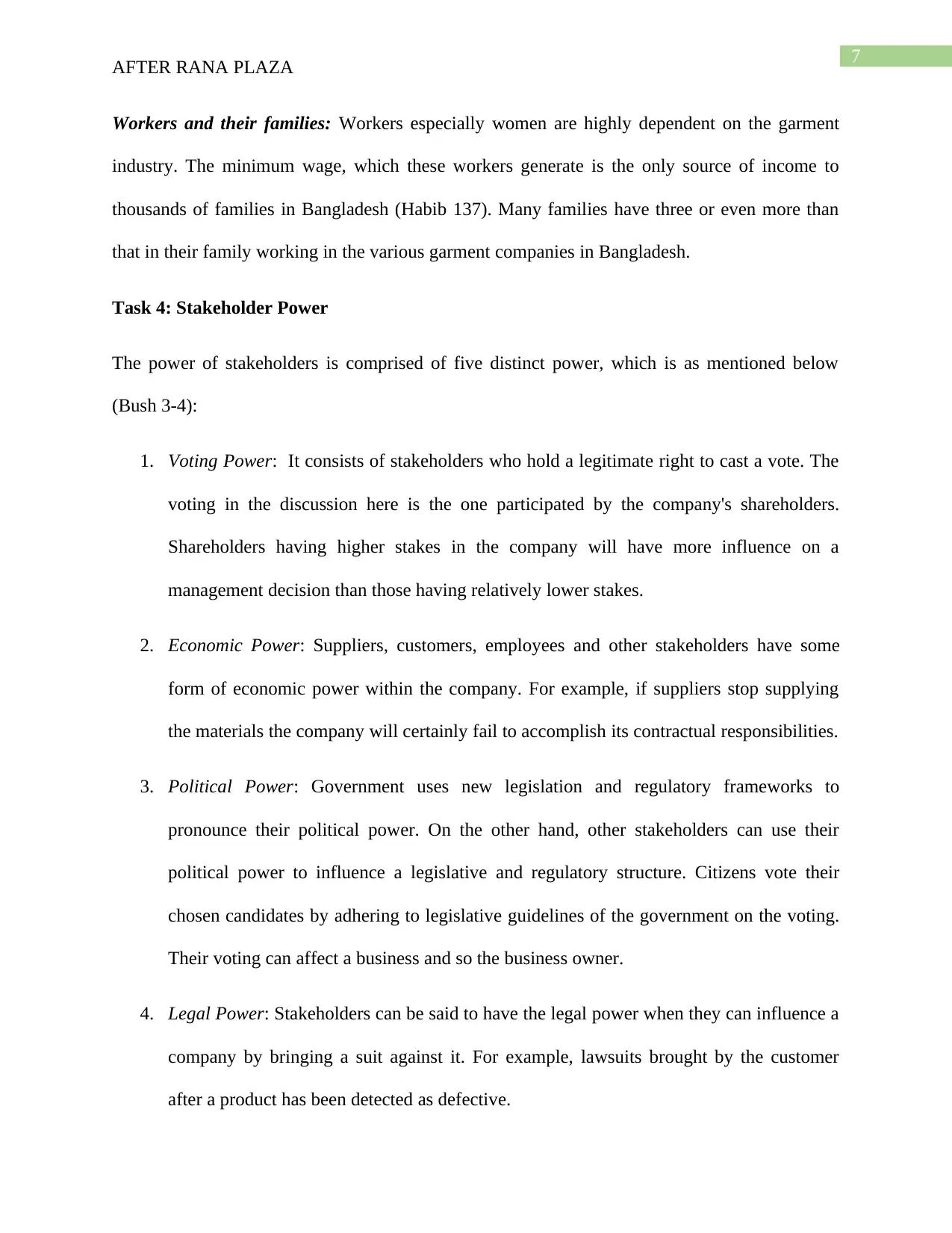
7
AFTER RANA PLAZA
Workers and their families: Workers especially women are highly dependent on the garment
industry. The minimum wage, which these workers generate is the only source of income to
thousands of families in Bangladesh (Habib 137). Many families have three or even more than
that in their family working in the various garment companies in Bangladesh.
Task 4: Stakeholder Power
The power of stakeholders is comprised of five distinct power, which is as mentioned below
(Bush 3-4):
1. Voting Power: It consists of stakeholders who hold a legitimate right to cast a vote. The
voting in the discussion here is the one participated by the company's shareholders.
Shareholders having higher stakes in the company will have more influence on a
management decision than those having relatively lower stakes.
2. Economic Power: Suppliers, customers, employees and other stakeholders have some
form of economic power within the company. For example, if suppliers stop supplying
the materials the company will certainly fail to accomplish its contractual responsibilities.
3. Political Power: Government uses new legislation and regulatory frameworks to
pronounce their political power. On the other hand, other stakeholders can use their
political power to influence a legislative and regulatory structure. Citizens vote their
chosen candidates by adhering to legislative guidelines of the government on the voting.
Their voting can affect a business and so the business owner.
4. Legal Power: Stakeholders can be said to have the legal power when they can influence a
company by bringing a suit against it. For example, lawsuits brought by the customer
after a product has been detected as defective.
AFTER RANA PLAZA
Workers and their families: Workers especially women are highly dependent on the garment
industry. The minimum wage, which these workers generate is the only source of income to
thousands of families in Bangladesh (Habib 137). Many families have three or even more than
that in their family working in the various garment companies in Bangladesh.
Task 4: Stakeholder Power
The power of stakeholders is comprised of five distinct power, which is as mentioned below
(Bush 3-4):
1. Voting Power: It consists of stakeholders who hold a legitimate right to cast a vote. The
voting in the discussion here is the one participated by the company's shareholders.
Shareholders having higher stakes in the company will have more influence on a
management decision than those having relatively lower stakes.
2. Economic Power: Suppliers, customers, employees and other stakeholders have some
form of economic power within the company. For example, if suppliers stop supplying
the materials the company will certainly fail to accomplish its contractual responsibilities.
3. Political Power: Government uses new legislation and regulatory frameworks to
pronounce their political power. On the other hand, other stakeholders can use their
political power to influence a legislative and regulatory structure. Citizens vote their
chosen candidates by adhering to legislative guidelines of the government on the voting.
Their voting can affect a business and so the business owner.
4. Legal Power: Stakeholders can be said to have the legal power when they can influence a
company by bringing a suit against it. For example, lawsuits brought by the customer
after a product has been detected as defective.
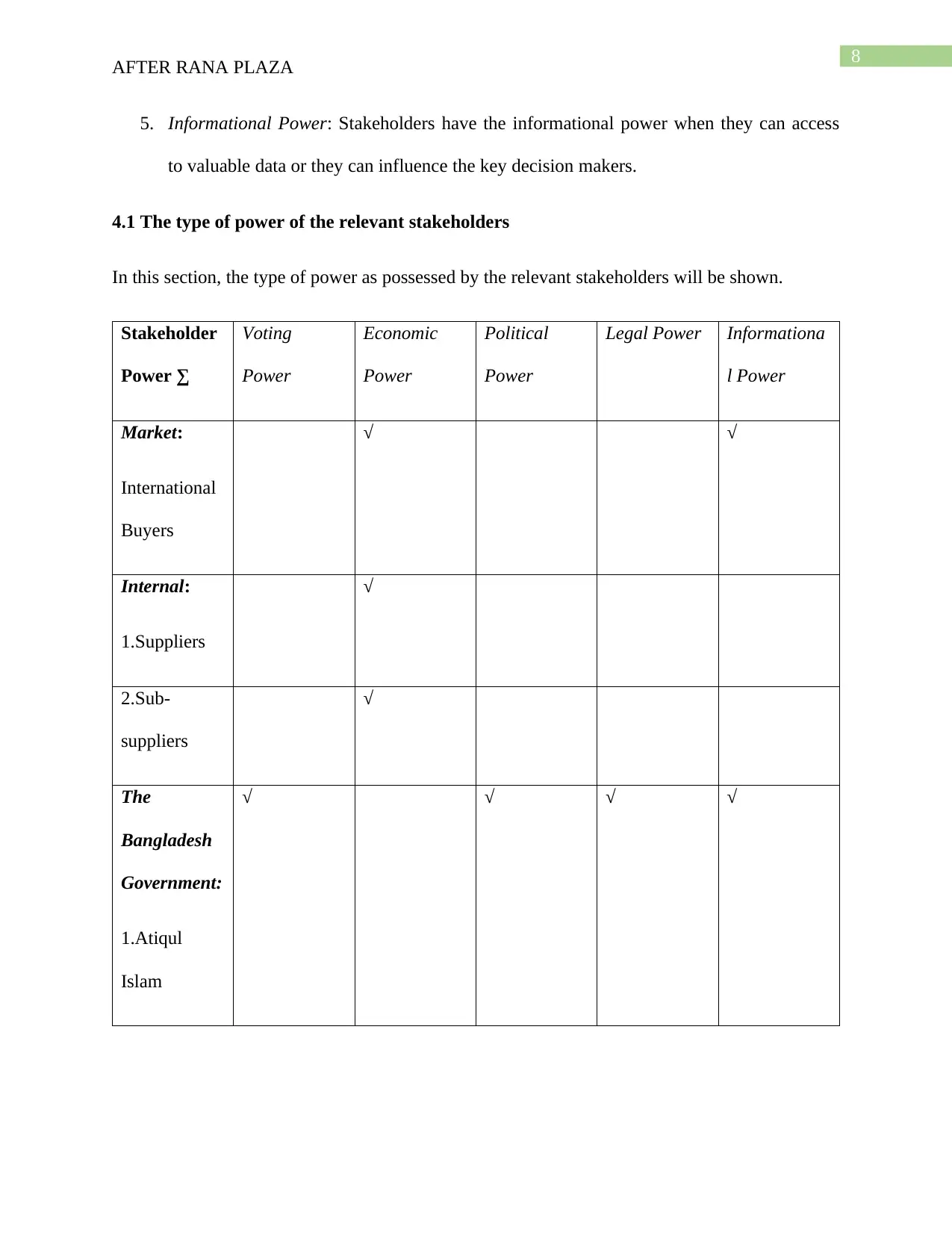
8
AFTER RANA PLAZA
5. Informational Power: Stakeholders have the informational power when they can access
to valuable data or they can influence the key decision makers.
4.1 The type of power of the relevant stakeholders
In this section, the type of power as possessed by the relevant stakeholders will be shown.
Stakeholder
Power ∑
Voting
Power
Economic
Power
Political
Power
Legal Power Informationa
l Power
Market:
International
Buyers
√ √
Internal:
1.Suppliers
√
2.Sub-
suppliers
√
The
Bangladesh
Government:
1.Atiqul
Islam
√ √ √ √
AFTER RANA PLAZA
5. Informational Power: Stakeholders have the informational power when they can access
to valuable data or they can influence the key decision makers.
4.1 The type of power of the relevant stakeholders
In this section, the type of power as possessed by the relevant stakeholders will be shown.
Stakeholder
Power ∑
Voting
Power
Economic
Power
Political
Power
Legal Power Informationa
l Power
Market:
International
Buyers
√ √
Internal:
1.Suppliers
√
2.Sub-
suppliers
√
The
Bangladesh
Government:
1.Atiqul
Islam
√ √ √ √
⊘ This is a preview!⊘
Do you want full access?
Subscribe today to unlock all pages.

Trusted by 1+ million students worldwide
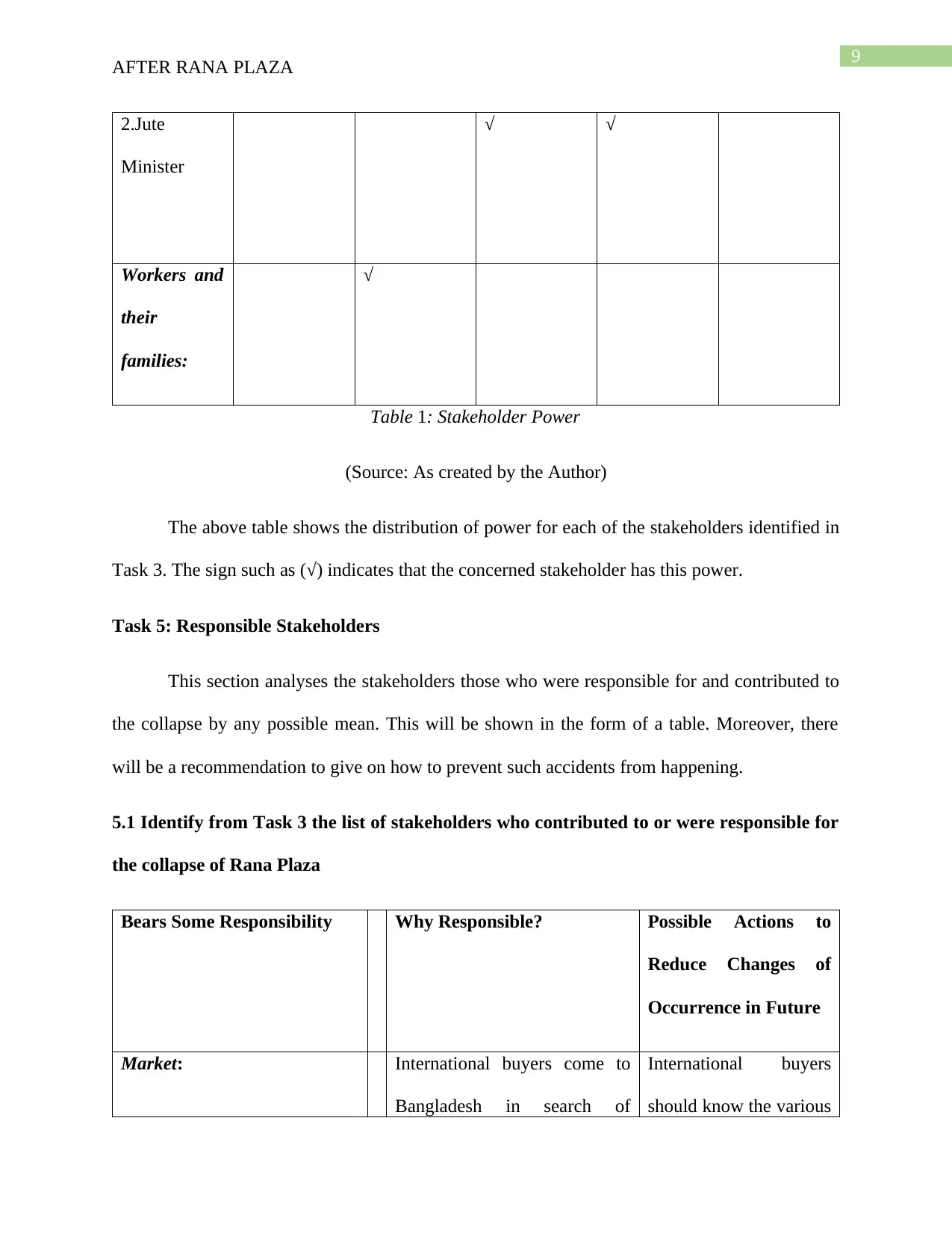
9
AFTER RANA PLAZA
2.Jute
Minister
√ √
Workers and
their
families:
√
Table 1: Stakeholder Power
(Source: As created by the Author)
The above table shows the distribution of power for each of the stakeholders identified in
Task 3. The sign such as (√) indicates that the concerned stakeholder has this power.
Task 5: Responsible Stakeholders
This section analyses the stakeholders those who were responsible for and contributed to
the collapse by any possible mean. This will be shown in the form of a table. Moreover, there
will be a recommendation to give on how to prevent such accidents from happening.
5.1 Identify from Task 3 the list of stakeholders who contributed to or were responsible for
the collapse of Rana Plaza
Bears Some Responsibility Why Responsible? Possible Actions to
Reduce Changes of
Occurrence in Future
Market: International buyers come to
Bangladesh in search of
International buyers
should know the various
AFTER RANA PLAZA
2.Jute
Minister
√ √
Workers and
their
families:
√
Table 1: Stakeholder Power
(Source: As created by the Author)
The above table shows the distribution of power for each of the stakeholders identified in
Task 3. The sign such as (√) indicates that the concerned stakeholder has this power.
Task 5: Responsible Stakeholders
This section analyses the stakeholders those who were responsible for and contributed to
the collapse by any possible mean. This will be shown in the form of a table. Moreover, there
will be a recommendation to give on how to prevent such accidents from happening.
5.1 Identify from Task 3 the list of stakeholders who contributed to or were responsible for
the collapse of Rana Plaza
Bears Some Responsibility Why Responsible? Possible Actions to
Reduce Changes of
Occurrence in Future
Market: International buyers come to
Bangladesh in search of
International buyers
should know the various
Paraphrase This Document
Need a fresh take? Get an instant paraphrase of this document with our AI Paraphraser
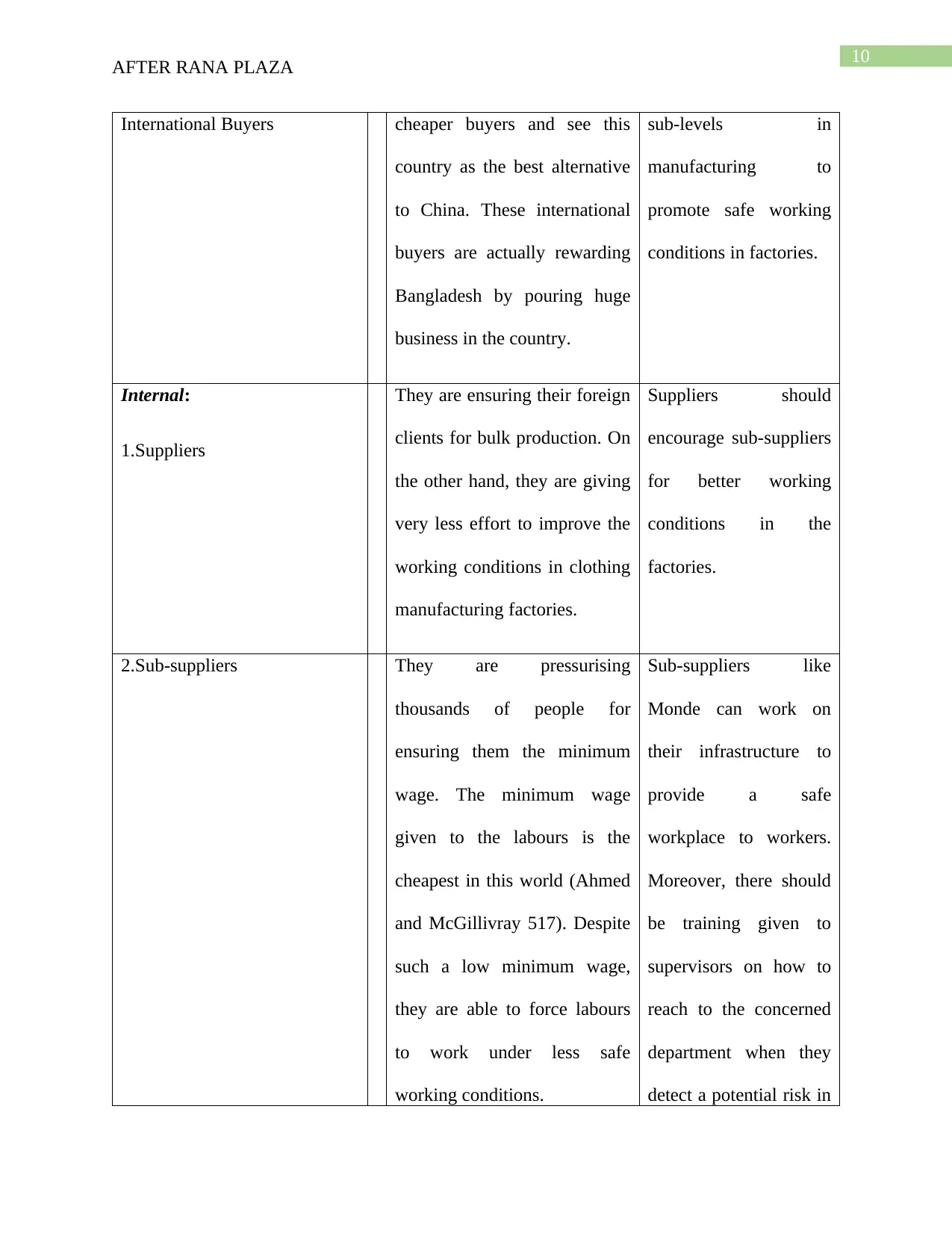
10
AFTER RANA PLAZA
International Buyers cheaper buyers and see this
country as the best alternative
to China. These international
buyers are actually rewarding
Bangladesh by pouring huge
business in the country.
sub-levels in
manufacturing to
promote safe working
conditions in factories.
Internal:
1.Suppliers
They are ensuring their foreign
clients for bulk production. On
the other hand, they are giving
very less effort to improve the
working conditions in clothing
manufacturing factories.
Suppliers should
encourage sub-suppliers
for better working
conditions in the
factories.
2.Sub-suppliers They are pressurising
thousands of people for
ensuring them the minimum
wage. The minimum wage
given to the labours is the
cheapest in this world (Ahmed
and McGillivray 517). Despite
such a low minimum wage,
they are able to force labours
to work under less safe
working conditions.
Sub-suppliers like
Monde can work on
their infrastructure to
provide a safe
workplace to workers.
Moreover, there should
be training given to
supervisors on how to
reach to the concerned
department when they
detect a potential risk in
AFTER RANA PLAZA
International Buyers cheaper buyers and see this
country as the best alternative
to China. These international
buyers are actually rewarding
Bangladesh by pouring huge
business in the country.
sub-levels in
manufacturing to
promote safe working
conditions in factories.
Internal:
1.Suppliers
They are ensuring their foreign
clients for bulk production. On
the other hand, they are giving
very less effort to improve the
working conditions in clothing
manufacturing factories.
Suppliers should
encourage sub-suppliers
for better working
conditions in the
factories.
2.Sub-suppliers They are pressurising
thousands of people for
ensuring them the minimum
wage. The minimum wage
given to the labours is the
cheapest in this world (Ahmed
and McGillivray 517). Despite
such a low minimum wage,
they are able to force labours
to work under less safe
working conditions.
Sub-suppliers like
Monde can work on
their infrastructure to
provide a safe
workplace to workers.
Moreover, there should
be training given to
supervisors on how to
reach to the concerned
department when they
detect a potential risk in
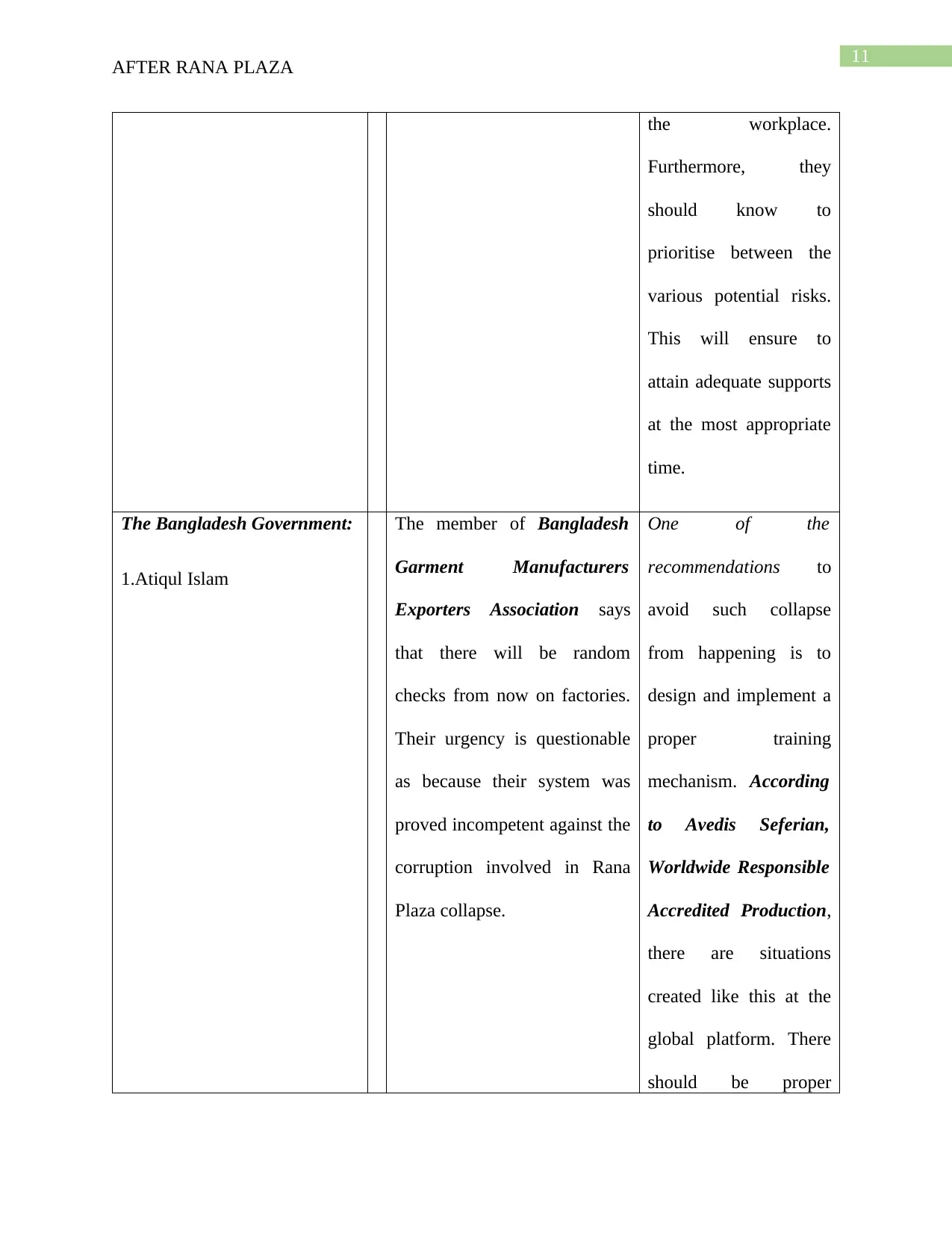
11
AFTER RANA PLAZA
the workplace.
Furthermore, they
should know to
prioritise between the
various potential risks.
This will ensure to
attain adequate supports
at the most appropriate
time.
The Bangladesh Government:
1.Atiqul Islam
The member of Bangladesh
Garment Manufacturers
Exporters Association says
that there will be random
checks from now on factories.
Their urgency is questionable
as because their system was
proved incompetent against the
corruption involved in Rana
Plaza collapse.
One of the
recommendations to
avoid such collapse
from happening is to
design and implement a
proper training
mechanism. According
to Avedis Seferian,
Worldwide Responsible
Accredited Production,
there are situations
created like this at the
global platform. There
should be proper
AFTER RANA PLAZA
the workplace.
Furthermore, they
should know to
prioritise between the
various potential risks.
This will ensure to
attain adequate supports
at the most appropriate
time.
The Bangladesh Government:
1.Atiqul Islam
The member of Bangladesh
Garment Manufacturers
Exporters Association says
that there will be random
checks from now on factories.
Their urgency is questionable
as because their system was
proved incompetent against the
corruption involved in Rana
Plaza collapse.
One of the
recommendations to
avoid such collapse
from happening is to
design and implement a
proper training
mechanism. According
to Avedis Seferian,
Worldwide Responsible
Accredited Production,
there are situations
created like this at the
global platform. There
should be proper
⊘ This is a preview!⊘
Do you want full access?
Subscribe today to unlock all pages.

Trusted by 1+ million students worldwide
1 out of 25
Your All-in-One AI-Powered Toolkit for Academic Success.
+13062052269
info@desklib.com
Available 24*7 on WhatsApp / Email
![[object Object]](/_next/static/media/star-bottom.7253800d.svg)
Unlock your academic potential
Copyright © 2020–2025 A2Z Services. All Rights Reserved. Developed and managed by ZUCOL.


